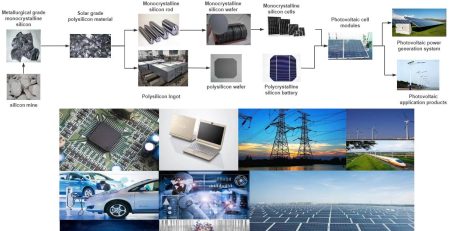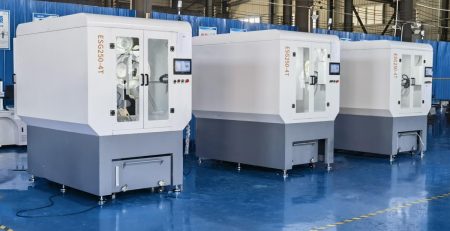Perspectivas de mercado de compósitos de matriz cerâmica
Perspectivas de mercado de compósitos de matriz cerâmica
According to a report by Research And Markets, um instituto internacional de pesquisa de mercado, the global ceramic matrix composites market is expected to grow from USD 11.35 billion in 2021 to USD 12.26 billion in 2022, at a CAGR of 8.05%. The market is expected to grow to USD 17.15 billion in 2026 at a CAGR of 8.75%.

Ceramic materials have excellent properties such as high melting point, alta dureza, resistência à corrosão, and oxidation resistance, and can be used in extreme environmental conditions, so they have been rapidly developed in the field of engineering, especially in aviation, aeroespaço, automotive, military and other fields. Contudo, the brittleness, mechanical unreliability and low electrical conductivity of ceramics limit their wide application. Introducing the second phase material into the ceramic matrix is an effective way to improve the structure and properties of ceramic materials.
As a result, ceramic matrix composites came into being.
Ceramic matrix composites (CMC) are composed of a ceramic matrix, reinforcing fibers and an interface layer. Fibers are introduced into the ceramic matrix as reinforcing materials to form a composite material with fibers as reinforcing phase and ceramic matrix as continuous phase.
It has the characteristics of high temperature resistance, resistência ao desgaste, high temperature creep resistance, low thermal conductivity, low thermal expansion coefficient, chemical corrosion resistance, high strength, alta dureza, dielectric and wave transmission.
Because it can be widely used in the working conditions where organic material-based and metal-based material cannot meet the performance requirements, it has become an ideal high-temperature structural material, and it has been paid more and more attention by people.
In particular, as a lightweight, high-performance structural composite material, it is widely used in high temperature fields, and has become the preferred material for aero-engines, especially core components of aero-engines. In view of this, many countries are actively conducting research on ceramic matrix composites.
C/SiC ceramic matrix composites
Carbon fiber not only has the characteristics of low density, high specific strength, resistência ao desgaste, resistência à corrosão, electrical conductivity, thermal conductivity, and low friction coefficient, but also has excellent high temperature mechanical properties.
In an inert atmosphere and an environment above 2000 °C, the mechanical properties still do not decrease. Contudo, its high temperature oxidation resistance is poor, so it is usually compounded with metals, cerâmica, resins, etc. to prepare advanced composite materials used in cutting-edge technology fields such as aerospace and military industries.
In the field of thermal structural ceramic matrix composites, silicon carbide has become one of the main candidates for matrix materials due to its excellent high-temperature mechanical properties (strength, oxidation resistance, creep resistance, etc.), low coefficient of thermal expansion and friction, excellent thermal and electrical conductivity.
Contudo, the disadvantage of SiC ceramics is that they are brittle.
C/SiC ceramic matrix composites strengthen SiC ceramics by adding carbon fibers, which can make the material absorb fracture energy by means of crack deflection, carbon fiber pull-out and fracture and other mechanisms during the fracture process.
It not only enhances the strength and toughness of the material, but also retains the excellent high temperature performance of the SiC matrix, which is an excellent way to prepare high-performance advanced structural materials.
It has become the main candidate material for high-performance aero-engines, and will be gradually applied to devices such as gas turbine hot-end components, high-speed brakes, nuclear energy, and heat exchangers.
SiCf/SiC composites
SiCf/SiC ceramic matrix composite material refers to the introduction of SiC fibers into the SiC ceramic matrix as a reinforcing material to form a composite material with the introduced SiC reinforcing fibers as the dispersed phase and the SiC ceramic matrix as the continuous phase.
SiCf/SiC ceramic matrix composites retain the advantages of high temperature resistance, high strength, oxidation resistance, corrosion resistance and impact resistance of SiC ceramics. At the same time, it has the effect of SiC fiber reinforcement and toughening, which overcomes the inherent defects of low fracture toughness and poor resistance to external impact load of SiC ceramics.
As a high-temperature thermal structural material with excellent comprehensive properties, SiCf/SiC composite has broad application prospects in aviation, aeroespaço, nuclear energy, automobile and other fields, and has become a research hotspot in various western countries.

Oxide/Oxide Ceramic Matrix Composites
Ox/Ox composite materials refer to a class of materials that are composited with oxide ceramics as a matrix and oxide fibers (generally 10-12 μm in diameter). The temperature resistance of this material is slightly lower than that of SiCf/SiC (about 1150°C), but because there is no oxidation problem,
Its service life can reach tens of thousands of hours, combined with low density (about 2.5g/cm3) and reasonable price, it is the preferred material for turboshaft, gas turbine core engine high temperature structure and turbojet, turbofan engine tail nozzle structure.
In terms of matrix, the current research focus at home and abroad is still quartz matrix, mullite matrix and alumina matrix. In terms of fiber, it is mainly divided into three categories: quartz fiber, aluminosilicate fiber and alumina fiber.
Graphene/Ceramic Matrix Composites
Graphene has excellent mechanical, electrical and thermal properties, making it one of the most attractive materials. At the same time, graphene has a large specific surface area and is easier to disperse in the ceramic matrix, which can improve the interface properties of ceramic matrix composites and enhance the combination with the ceramic matrix.
It is beneficial to the transfer of electrons, phonons and mechanical stress, and is an ideal filler for the preparation of ceramic composites with excellent performance. Numerous studies have shown that graphene/ceramic composites have excellent mechanical properties, electrical conductivity, thermal conductivity, friction and wear resistance, etc.
summary
In addition to the application of a large number of ceramic matrix composites in the aerospace and defense fields, the high demand for lightweight vehicles worldwide in the future will also promote the rapid growth of the ceramic matrix composites market.
In order to increase the cruising range of electric vehicles, in addition to increasing battery performance, another method is to reduce the weight of the car. This will prompt automakers to turn their attention to lightweight composites to replace heavier steel and iron in vehicles, with ceramic matrix composites undoubtedly one of the most important candidates.
According to data from McKinsey, the use of lightweight materials in the automotive industry is expected to increase from 30% Para 70% by 2030, which will greatly promote the development of the ceramic matrix composites market.


